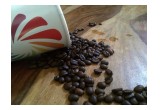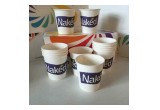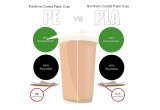
Scyphus in one their blog posts from the past has debated on who should take the responsibility of being the eco-friendly partner in the whole coffee consumption cycle. They said that they have been actively researching and developing the 100 percent Compostable Paper Cup along with their Recyclable and Biodegradable Paper Cup (after extraction of the PE layer) but more research is required.
Northampton, England, June 27, 2017 (Newswire.com) - PLA vs PE, or Biodegeadable vs. Recyclable Printed Paper Cups. Yes of course more research and to be precise, more research funding is required and most importantly, the big wigs in the coffee retail should invest more, governments should specifically allocate funds for the research institutions to collaborate with industry partners like Scyphus to develop a perfect Biodegradable Coating that is commercially viable and as resilient as a PE too. But that's another debate. We called Leslie Carr, director of UK company Bio Paper Cups to know a little more about PE and PLA, and placed 10 questions for him to answer.
The "You" in the debate
You’ve just wrapped your mitts around a steaming latte-to-go. Ahh…. Your first caffeine fix of the day! Ever wondered why the paper cup holding your delicious beverage isn’t leaking all over your hands? Or whether your cup is coated in PE plastic or PLA? Probably not. But if you have any concern for the earth — or the future generations that’ll inherit it — you need to sit down and have a good think what paper cups are made of.
Leslie Carr, director of UK company Bio Paper Cups, explains why it’s all in the coating.
Q1. What is PE and PLA and how are they different?
PE stands for polyethylene. It’s the type of plastic most commonly used around the world for plastic bags, packaging and containers. It’s also used as a coating on paper cups to make them strong and waterproof.
PLA, on the other hand, is made from plant-based materials such as corn starch or sugar cane. It’s known as a bioplastic because these materials are renewable resources.
The thing with PE is that it’s petroleum-based, which can affect how long it takes for the cup to break down. PE-lined cups can still be recycled, but they have to go through a recycling process separate to other recyclables.
PLA, on the other hand, is totally biodegradable and can be composted. PLA breaks down naturally when it’s exposed to the environment, and it doesn’t leave any toxic residues.
Q2. Why is plastic used as a coating on paper cups?
A paper cup needs to be waterproof, obviously, or it wouldn’t handle what’s poured into it! The first paper cups were made waterproof using a thin coating of clay, but as you can imagine, this made the drink taste pretty nasty! Wax was also used for a while, then somebody invented PE. PE was like a magic solution because it made the cups strong and waterproof, and it had no impact on the taste.
Q3. How did PLA come about?
PLA was invented way back in the 1920s, but at the time it was too costly to use commercially.
Then in 1989 someone discovered that PLA could be made from corn starch. This was a big deal, because it meant there was now an environmentally-friendly bioplastic that was both affordable and cost-efficient.
Q4. When did your company start producing PLA-coated cups and why?
Bio Paper Cups started manufacturing with PLA in early 2015 after numerous customer requests. As any business knows, the customer is always right! People wanted a bioplastic that was fully compostable, and PLA was the perfect solution.
Q5. So, does PLA work as well as PE?
That’s a question we get asked a lot! PLA has improved markedly since it was first invented. Because it’s made from plant-based material rather than plastic, people are sometimes unsure whether PLA is as strong and heat-resistant as PE.
The answer is yes, it is — PLA is capable of handling everything that PE can handle. At the moment, the demand for PE is still greater than PLA, but we believe that’s because people aren’t fully aware of the benefits of PLA yet.
Q6. What are the advantages of PLA?
There are so many! The biggest one is that PLA-lined cups can go straight into the composting bin, whereas other paper cups have to go through a separate recycling process.
Then there’s the fact that PLA comes from renewable resources, which reduces landfill. We all know how important that is these days. Another big one is that PLA can be manufactured using the same equipment used for making other plastics, so it’s just as cost-efficient to produce.
Q7. What is the general opinion of PLA?
We’ve found that once people understand how good PLA is, they’re pretty much sold on it.
One of our customers, Naked Juice, chose to use our PLA-lined cups for one of their events. They needed cups that could go straight into the composting bin, which is exactly what PLA cups do.
We had some great feedback from that one. We’re also seeing lots of smaller café owners shifting to PLA cups, which is fantastic. These guys have seen the advantages in using 100 percent biodegradable cups and many of them use it as a marketing tool. The idea that your takeaway coffee is in a fully-compostable and biodegrable cup is a bit of a selling point!
Q8. Is PE bad then?
Not at all. It’s just that PE can slow down the biodegradability of the paper cup. We prefer PLA because it does everything that PE does, but the recycling process is just that much simpler.
Q9. What do people need to know about the coating on paper cups?
Because all paper cups can be recycled regardless of whether they’re lined with PE or PLA, most people don’t really even think about what their paper cup is lined with. But we’re at a point where the planet needs all the help it can get. If we can speed up the recycling process by using fully-compostable cups, that’s surely a good thing! It’s important to think more about sustainability of resources as well.
Q10. What’s your forecast for the future of PLA-lined paper cups?
Our big dream, of course, is to have the giants of the coffee world like Starbucks and Costa follow the lead of smaller café owners and take on PLA cups as well. It’s great that Starbucks and Costa use paper cups instead of plastic, of course, but PLA cups would make the recycling process even faster! We believe in sustainability, so we’ll keep pushing for PLA.
In the meantime, anything that cuts down the recycling process is good, so our focus is to make that process as simple as possible. We’ve been talking with town councils and recycling companies about collaborating on special bins for paper cups, which could be picked up by our own recycling company.
This would reduce contamination and landfill. Ultimately, a paper cup should be both disposable and biodegradable. We need to think about future generations and how our current waste production is going to affect them. Every change we make now will help!
Source: Scyphus, UK
Share:



